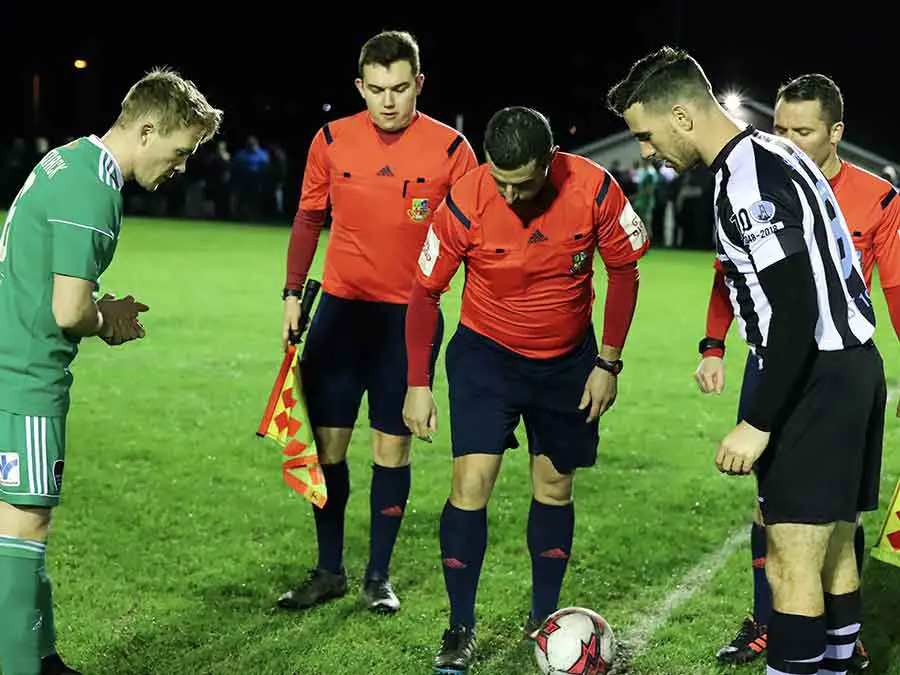Coin Toss
What is a Coin Toss in Soccer? Understanding the Pre-Game Ritual
A coin toss in soccer is a simple yet crucial aspect of the game that determines which team kicks off and which side of the field each team defends at the start of the match.
This customary pre-game ritual, often overlooked by spectators, plays a significant role in setting the tone for the competition and can have subtle strategic implications for both teams.

Conducted by the match referee, the coin toss involves a representative from each team – usually the captain – and takes place at the center of the field. The referee flips the coin, and the visiting team captain is given the opportunity to choose heads or tails.
The winning captain then selects either which side of the field to defend or to initiate the kick-off, with the opposing captain choosing the remaining option.
In addition to establishing initial match conditions, the coin toss can also influence team strategies, such as taking advantage of prevailing weather conditions, field surface, or even psychological factors.
Knowing this seemingly trivial aspect of soccer can provide a deeper understanding of the game’s finer nuances and the different tactics employed by teams.
Coin Toss Purpose
A coin toss in soccer serves a few important purposes, which are explained in detail in the sub-sections below.
Determining Sides
Firstly, the coin toss is used to determine which team will play on which side of the field. The team captain who wins the toss is allowed to choose which goal they want to defend during the first half of the match.
This decision can be influenced by factors such as the position of the sun, wind direction, and pitch conditions, as the team may want to take advantage of these factors during gameplay.

Choosing Kickoff
Another purpose of the coin toss in soccer is deciding which team will kick off the game. The team captain who loses the coin toss must choose to either kick off or select their preferred side of the field.
By choosing to kick off, a team can gain early possession of the ball and try to establish an attacking rhythm from the very start. Additionally, the team that kicks off the first half will also kick off at the second half, giving them the opportunity to regroup and make a strong start in both halves of the match.
Coin Toss Procedure
The coin toss in soccer is an important pre-match procedure that helps determine which team gets to choose the side of the field or gets to have the first possession of the ball. This procedure involves the team captains and the referee. It is essential for the participants to understand the coin toss procedure to ensure a fair start to the match.
Pre-match
Before the match begins, the referee gathers the captains of both teams at the center of the field. They will have a brief conversation, usually about the match’s rules, ground conditions, and other relevant topics. Then, the referee will initiate the coin toss.
Captains’ Roles
The captains play a vital role in the coin toss. One captain is selected to call the toss, while the other captain is there to confirm and observe. The captain calling can choose between two options, such as ‘heads’ or ‘tails’. The referee will then flip the coin, and depending on the result, the captain who called correctly will get to choose the side or first possession.
Referee’s Responsibilities
The referee is responsible for carrying out the coin toss procedure. Their tasks involve:
- Bringing the captains together at the center of the field
- Having a brief discussion regarding the match rules and conditions
- Flipping the coin and observing the outcome
- Resolving any disputes or issues that may arise during the process
- Communicating the coin toss results to both teams
Once the coin toss procedure is complete, the teams prepare to start the match, and the referee ensures smooth gameplay throughout the game.
Additional Coin Toss Situations
Tiebreakers
In soccer tournaments or playoff matches, a tiebreaker may be used to determine the winner if the match ends in a draw after regular time. One of the most common tiebreakers is extra time, which consists of two 15-minute halves. A coin toss is conducted before extra time to decide which team kicks off and which side of the field they will defend.
Kicks from the Penalty Mark
If the match is still tied after extra time, the game moves to kicks from the penalty mark, also known as a penalty shootout. The referee conducts another coin toss to determine the team that kicks first and the goal to be used for the shootout.
Both teams choose five players, who must be on the field at the end of extra time, to take alternating penalty kicks. If the score is still tied after these five kicks, the process continues with sudden-death penalty kicks until a winner is determined.
Coin Toss in Other Sports
While soccer uses a coin toss to determine which team kicks off and which side they start on, other sports utilize similar practices for various reasons.
For example, American football employs the toss at the beginning to decide which team will kick or receive, and also in case of a tie during overtime. Basketball also features pre-game coin tosses as required, especially in non-professional settings, to establish initial possession. Tennis utilizes the toss to determine which player serves first and which side they elect to start on.
Some additional sports that implement coin tosses include:
- Cricket – for selecting batting or fielding choices
- Volleyball – to assign initial serves and court sides
- Table tennis – to determine serve and side choices
While the primary purpose of coin tosses in various sports is related to game starts or side selections, they also serve as a symbol of impartiality and fairness. Coin tosses ensure an equitable process and convey the fundamental importance of sportsmanship.
